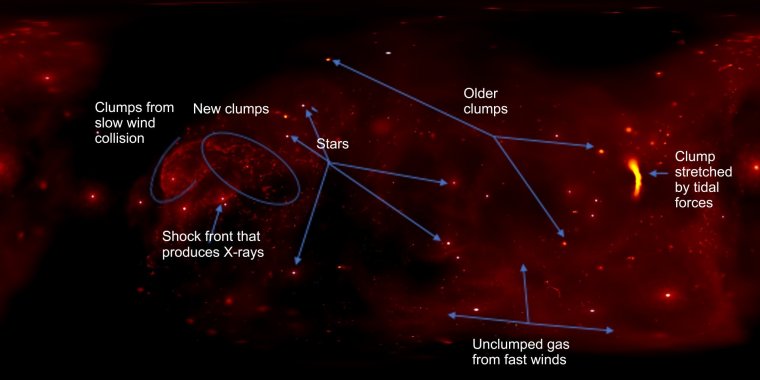| News / Science News |
Scientists Take Viewers to the Center of the Milky Way
The Earth is located about 26,000 light-years, or about 150,000 trillion miles, from the center of the Galaxy. While humans cannot physically travel there, scientists have been able to study this region by using data from powerful telescopes that can detect light in a variety of forms, including X-ray and infrared light.

Labeled Image of Galactic Center. Image credits: NASA/CXC/Pontifical Catholic Univ. of Chile /C.Russell et al.
This visualization builds on infrared data with the European Southern Observatory's Very Large Telescope of 30 massive stellar giants called Wolf-Rayet stars that orbit within about 1.5 light years of the center of our Galaxy. Powerful winds of gas streaming from the surface of these stars are carrying some of their outer layers into interstellar space.
When the outflowing gas collides with previously ejected gas from other stars, the collisions produce shock waves, similar to sonic booms, which permeate the area. These shock waves heat the gas to millions of degrees, which causes it to glow in X-rays.
Extensive observations with Chandra of the central regions of the Milky Way have provided critical data about the temperature and distribution of this multimillion-degree gas.
Astronomers are interested in better understanding what role these Wolf-Rayet stars play in the cosmic neighborhood at the Milky Way's center. In particular, they would like to know how the stars interact with the Galactic center's most dominant resident: the supermassive black hole known as Sagittarius A* (abbreviated Sgr A*). Pre-eminent yet invisible, Sgr A* has the mass equivalent to some four million Suns.
Scientists have used the visualization to examine the effects Sgr A* has on its stellar neighbors. As the strong gravity of Sgr A* pulls clumps of material inwards, tidal forces stretch the clumps as they get closer to the black hole. Sgr A* also impacts its surroundings through occasional outbursts from its vicinity that result in the expulsion of material away from the giant black hole, as shown in the later part of the movie.
These outbursts can have the effect of clearing away some of the gas produced by the Wolf-Rayet winds. (NASA)
YOU MAY ALSO LIKE




